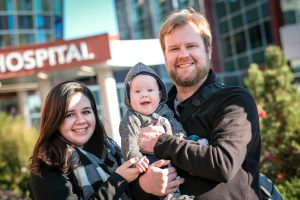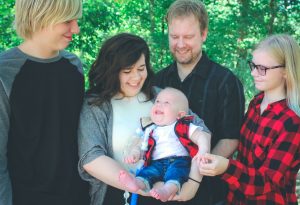All any mom hopes for is a safe pregnancy, a complication-free birth and a healthy and happy baby. For first-time mom Darby Muller, an unsettling discovery at her 20-week ultrasound made these wishes uncertain. When Darby, and her husband Brad, went in for a routine check-up at their family care provider in Fort Dodge, Iowa, the doctors diagnosed baby Muller with spina bifida, a birth defect that occurs when a section of the baby’s spinal column does not form properly and a gap appears.
healthy and happy baby. For first-time mom Darby Muller, an unsettling discovery at her 20-week ultrasound made these wishes uncertain. When Darby, and her husband Brad, went in for a routine check-up at their family care provider in Fort Dodge, Iowa, the doctors diagnosed baby Muller with spina bifida, a birth defect that occurs when a section of the baby’s spinal column does not form properly and a gap appears.
Sometimes, the protective membranes around the spinal cord push out through the gap and form a sac-like structure. In baby Muller’s case, the spinal cord and nerves protruded into the sac, a condition called myelomeningocele or spina bifida cystica. These developments can result in progressive and permanent injuries. Babies born with spina bifida often have major disabilities, including weakness or paralysis of the legs and feet, bowel and bladder dysfunction and learning problems.
The Mullers make their way to Minnesota
After confirming the diagnosis with a second physician in Des Moines, Iowa, the Mullers were referred by Dr. Jona Conklin to Midwest Fetal Care Center (MWFCC). The MWFCC is a collaboration between Allina Health and Children’s Minnesota that brings together a multi-disciplinary team of highly trained maternal-fetal medicine experts from Allina Health, and pediatric and neonatal specialists from Children’s Minnesota. Upon referral to MWFCC, the Mullers were paired with fetal care clinical social worker Anne Seaton as they began navigating this challenging diagnosis.
A social worker steps in to support
Social workers are often a less well-known part of the care team. After the baby is prenatally diagnosed, the social worker empowers the family to play an active role in the decision-making process during the remainder of the pregnancy, birth and after-care. They help families weigh the pros and cons of various treatments and support them in whatever option they choose.
Due to remarkable medical innovations, myelomeningocele (MMC), the most common form of spina bifida, can be treated prenatally through a surgical procedure known as MMC repair. After the medical care team and Anne identified Darby and baby Muller as good candidates for surgery, the first major decision the family faced was whether to opt for prenatal or postnatal spinal repair surgery. With the counseling and support of Anne, the Mullers ultimately decided on the prenatal repair option.
Although prenatal MMC repair is not a cure for spina bifida, research shows that it can offer significantly better results than traditional postnatal repair. Prenatal repair can dramatically reduce the effects of spina bifida by:
- Reducing the need to insert a special tube, or shunt, into the baby’s head after birth to drain excess fluid caused by hydrocephalus.
- Improving and reversing the Chiari II malformation, also known as the shifting of the baby’s brain into the spinal canal. This improvement potentially reduces long-term or lifelong health problems, such as scoliosis, difficulty swallowing or breathing, and syringomyelia.
- Improving neurocognitive function.
- Significantly improving the ability of the child to walk unassisted.
Baby Muller’s surgery
Prenatal MMC repairs are performed between 22 weeks and 25 weeks and six days. On Dec. 27, 2019, Dr. Joseph Lillegard, Dr. Joseph Petronio and Dr. Saul Snowise led the operating team using the “open” technique. First, Darby and baby were placed under general anesthesia so that both could be operated on simultaneously. Then, a horizontal incision of about 6-7 centimeters was made in Darby’s lower abdomen. Using ultrasound imaging, the surgical team made a safe incision in the uterus, exposing the spinal defect in baby Muller. With the baby’s back in view, the surgeons created a watertight closure of the defect and surrounding tissue.
 During the procedure, all hands are on deck; a multidisciplinary team, including anesthesiologists for mom and baby, fetal cardiologists, circulating nurses from both Children’s Minnesota and MWFCC, and five surgeons, 2-3 of which are pediatric surgeons, are present. Logistically and technically, MMC repairs are a big deal. Children’s Minnesota and the Midwest Fetal Care Center collaboratively average 15-17 repairs a year, making the program one of the largest in the country.
During the procedure, all hands are on deck; a multidisciplinary team, including anesthesiologists for mom and baby, fetal cardiologists, circulating nurses from both Children’s Minnesota and MWFCC, and five surgeons, 2-3 of which are pediatric surgeons, are present. Logistically and technically, MMC repairs are a big deal. Children’s Minnesota and the Midwest Fetal Care Center collaboratively average 15-17 repairs a year, making the program one of the largest in the country.
The surgery went well, but because Darby’s amniotic fluid volumes were unstable and she experienced abdominal pain, she was readmitted several times. In case of emergency, Darby stayed in Allina Health’s patient apartments where she could be more easily monitored.
“Since Darby’s surgery in 2019, we’ve continued to refine prenatal repairs. For example, surgical advances now make it possible to sometimes repair myelomeningocele with a less invasive technique called fetoscopic MMC repair,” said Dr. Petronio. “Fetoscopic MMC repair eliminates the need for a large incision in the uterus, reducing the risk of rupturing the uterus, and allowing the mother the ability to have a vaginal delivery. It’s important to note the repair option chosen is largely dependent on the best outcomes for mom and baby. Patient outcomes are at the root of every decision we make at Children’s Minnesota.”
Odin’s birth
Odin Muller was born at 35 weeks gestation via Cesarean section (C-section) on March 9, 2020. His birth would be followed by a 143 day stay in the neonatal intensive care unit (NICU) at Children’s Minnesota to address the spinal repair site unexpectedly reopening at birth and the respiratory distress he was experiencing.
“It was very comforting to know the dream team of doctors was there to guide us and our son through this long and sometimes scary journey,” said Darby. “Dr. Petronio, who Odin still sees for after-care, created a sense of calm in our son’s diagnosis. He always ensured Odin would have a good life. He brought a lot of joy to us and provided stability to our lengthy stay at Children’s Minnesota.”
The benefits of Children’s Minnesota’s wraparound services
Throughout lengthy hospital stays and long roads to recovery, many patient family needs are met through Children’s Minnesota wraparound services and dedicated staff roles; from the obvious like doctors and nurses to the more nuanced like child life specialists, dieticians, music therapists, social workers, spiritual counselors and more.
Baby Odin today
“Odin has been through a lot in his young life. While there have been complications since his birth, he’s getting stronger every day,” said Dr. Petronio. “The movement and function of his legs has improved, much of which is a result of the benefits of prenatal MMC repair. He is currently being weaned off his ventilator, a process that we predict will be complete within a year. We expect to continue to see developmental improvements now that he is home with his family.”
complications since his birth, he’s getting stronger every day,” said Dr. Petronio. “The movement and function of his legs has improved, much of which is a result of the benefits of prenatal MMC repair. He is currently being weaned off his ventilator, a process that we predict will be complete within a year. We expect to continue to see developmental improvements now that he is home with his family.”
As mentioned, Odin receives follow-up care with Dr. Petronio at the Children’s Minnesota spina bifida clinic. We’re grateful to be a part of the Mullers journey, we wish them the best and can’t wait to watch Odin grow up.